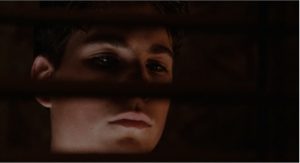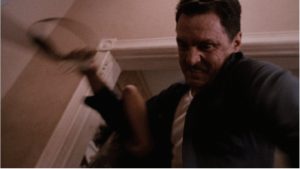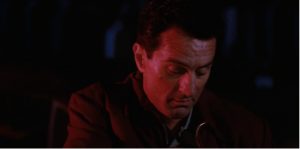There is a lot of interesting mise-en-scene in Goodfellas. My chosen scene begins at night, where Tuddy Cicero (Frank DiLeo) greets Tony Stacks (Tony Sirico). Most of the light in the scene comes from inside the building (practical lighting) and some additional lights outside the frame. The warm hue of the light, mixed with the open body language of the people outside, emphasise the inviting scene and Henry’s longing to join. The busy and untidy interior of Henry’s house contrasts with the brighter and more organised atmosphere of the Mafia’s establishments. The blinds obscuring parts of Henry’s face could represent the prison his house feels like when compared to the respect he has as a trainee gangster. Signs of wealth and power, such as the Cadillacs, cigarettes, money, alcohol, shrimp and lobsters, gambling and corrupt judges are all seen in the first ten minutes: creating a context for Henry’s enamourment with this lifestyle.

Henry, Goodfellas (1990), looking dejectedly out of the window
To further the pace at which the story is opened, the camera is often handheld or panning, frequently zooming in or out to focus more on a subject or to give more detail about the scene (respectively, whilst retaining pace); such as a close up of Paulie’s hands writing a list, panning out to see Henry waiting for Paulie, whilst looking at a group of people in the background. Wide shots are often used, especially outside, to convey the large scale of all the interconnected parts of the operation within this small neighbourhood. A clear dominant relationship is established between Henry and his father by the father’s height compared to Henry, in a standard and reverse dirty 2-shot of the pair and when he beats Henry. This is contrasted in the next shot by Henry in a low angle compared to Paulie, despite Paulie having a higher rank within the organisation: helping to convey the greater sense of respect Henry is attracted to within the organisation when compared to at home. Slow-motion (slo-mo) is used when Henry first meets Jimmy to emphasise the amount of awe and respect he has for him. Many freeze-frames, such as the one following Jimmy’s introduction, are used to give extensive backstory or other information about a character.

Goodfellas (1990), a low angle freeze-frame of Henry’s father beating him
Most lighting used is natural, with practical, low-key, lights used typically at night and in nightclubs, to further add realism to the scene. When non-practical lights are used, they are used deliberately and to achieve a specific effect. An attached red light is used on Jimmy’s face to exude his serious intentions when he converses with a lorry driver. Attached shadows are also used effectively on Jimmy when he congratulates Henry in private after Henry is found not to be guilty: highlighting Jimmy’s eyes as he holds eye contact.

Goodfellas (1990), Jimmy conversing with the lorry driver
In this scene, music is almost constantly playing. The lyrics often reflect the subject of the locale’s events: during the first song, as a mobster steps out of the car, ‘must I always be a beggar?’ parallels Henry’s internal feelings at seeing the opulent suit and shoes of the man who exits the car. Music transitions from track to track very fast and are always non-diegetic and parallel to the on-screen action. There is almost constant narration throughout this whole scene which relates to the diegesis. Sound effects, such as the belt whacking, are also mostly parallel. Some sound effects are almost contrapuntal, such as the explosion which carries on playing after the freeze-frame has taken effect. Some sound effects also act as sound bridges, such as the sound of glass bottles clanking which connects the shot of the bottles being pocketed with a shot of Henry: whom we infer must be in the bar.
The editing drives the pace of the scene with straight cuts connecting several reoccurring locales. Continuity editing rules are occasionally broken: such as in the case when the shot of Henry, from outside the window, cuts with a shot over 85 degrees on his right. In a wider sense, continuity editing is often not obeyed – as there are time skips between locales. Additionally, eyelines are not always matched, as is the case with Henry and his father or with Henry and Paulie. Although much of the editing was inspired by the first several minutes of Jules and Jim, the editing of Goodfellas was still incredibly influential. In 2012, the Motion Picture Editors Guild ranked Goodfellas as the fifteenth best-edited film of all time. It won the BAFTA Film Award (British Academy Film Award) for Best Editing in 1991.
![Film Analysis (2001: A Space Odyssey | Goodfellas) [Part 7]](https://joestudios.co.uk/wp-content/uploads/2021/04/DSCF0361-Optimised.jpg)